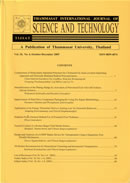ThaiScience
ThaiScience
THAMMASAT INTERNATIONAL JOURNAL OF SCIENCE & TECHNOLOGY
Volume 26, No. 01, Month JANUARY, Year 2021, Pages 142 - 151
Response of ‘hua-ruea’ chili pepper (capsicum annuum l.) to salicylic acid under heat stress
Sudchai Locharoen, Pariyanuj Chulaka
Abstract Download PDF
Environmental stress, especially high air temperature (Tair) and high vapour pressure deficit (VPD) affect photosynthesis which is directly related to productivity. In this study, salicylic acid (SA), at concentrations of 10-5 and 10-7 M, was tested for the ability to ameliorate physiological stress, improve the protein profile, and increase chili pepper yield under extreme environmental conditions. Salicylic acid at a concentration of 10-7 M (SA10-7) increased the net photosynthetic rate (Pn), stomatal conductance (gs), intercellular CO2 concentration, transpiration rate, and maximum quantum efficiency of PSII photochemistry (Fv/Fm) when temperature was lower than 37 °C and VPD was less than 3 kPa. In addition, SA10-7 could stimulate the synthesis of proteins associated with photosynthesis, such as chloroplast Rubisco activase, which promoted photosynthesis in chili pepper leaves. However, fruit number and fruit quality were not significantly different between the SA treatments (10-5 and 10-7 M) and control. Based on the results, SA application can improve photosynthesis of chili pepper plants, if the temperature does not exceed 37°C and VPD is less than 3 kPa.
Keywords
Heat stress, Leaf gas exchange, Chili pepper, Plant hormones, ProteomicTHAMMASAT INTERNATIONAL JOURNAL OF SCIENCE & TECHNOLOGY
Published by : Thammasat University
Contributions welcome at : http://www.tijsat.tu.ac.th
